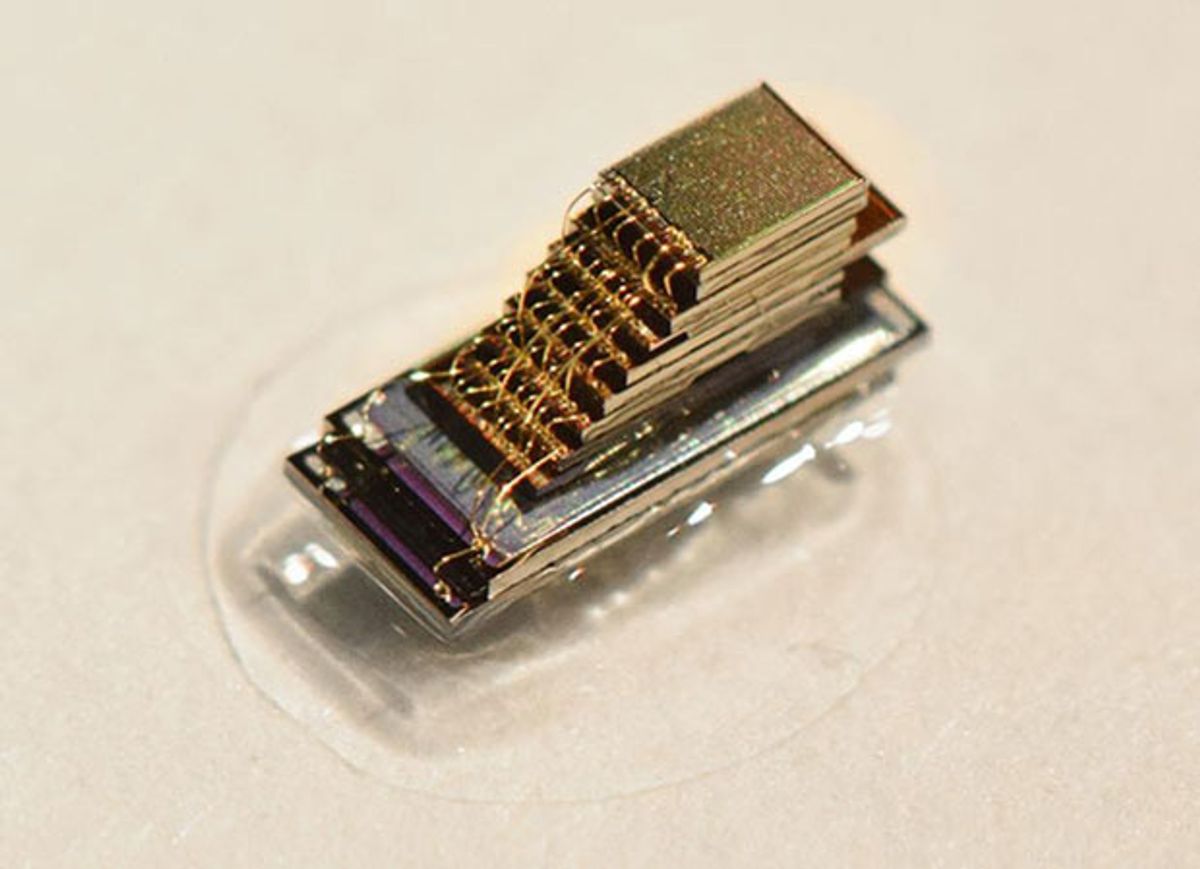Computer scientist David Blaauw pulls a small plastic box from his bag. He carefully uses his fingernail to pick up the tiny black speck inside and place it on the hotel café table. At 1 cubic millimeter, this is one of a line of the world’s smallest computers. I had to be careful not to cough or sneeze lest it blow away and be swept into the trash.
Blaauw and his colleague Dennis Sylvester, both IEEE Fellows and computer science professors at the University of Michigan, were in San Francisco in February to present 10 papers related to these “micromote” computers at the IEEE International Solid-State Circuits Conference (ISSCC). They’ve been presenting different variations on the tiny devices for a few years now.
The broad goal of the Michigan Micro Mote (M3) initiative is to make smarter, smaller sensors for medical devices and the Internet of Things—sensors that can do more with less energy. Many of the microphones, cameras, and other sensors that make up the eyes and ears of smart devices are always on alert, and frequently they beam personal data into the cloud because they can’t analyze it themselves. Some have predicted that by 2035, there will be 1 trillion such devices. “If you’ve got a trillion devices producing readings constantly, we’re going to drown in data,” says Blaauw. By developing tiny, energy-efficient computing sensors that can do analysis on board, Blaauw and Sylvester hope to make these devices more secure, while also saving energy and bandwidth.
In San Francisco, they described micromote designs that use only a few nanowatts of power to perform tasks such as distinguishing the sound of a passing car and measuring temperature and light levels. They showed off a compact radio that can send data from the small computers to receivers 20 meters away—a considerable boost compared with the 50-centimeter range they reported last year. They also described their work with TSMC (Taiwan Semiconductor Manufacturing Co.) on embedding flash memory into the devices and a project to bring on board dedicated, low-power hardware for running artificial intelligence algorithms called deep neural networks.
Blaauw and Sylvester say they take a holistic approach to adding these new features without ramping up power consumption. “There’s no one answer” to how they and their engineers do it, says Sylvester. If anything, it’s “smart circuit design,” Blaauw adds. (They pass ideas back and forth rapidly, not finishing each other’s sentences but something close to it.)
The memory research is a good example of how the right trade-offs can improve performance, says Sylvester. Previous versions of the micromotes used 8 kilobytes of SRAM, which makes for a pretty low-performance computer. To record video and sound, the tiny computers need more memory. So the group worked with TSMC to bring flash memory on board. Now they can make tiny computers with 1 megabyte of storage.
Flash can store more data in a smaller footprint than SRAM, but it takes a big burst of power to write to the memory. With TSMC, the group designed a new memory array that uses a more efficient charge pump for the writing process. The memory arrays wind up being a bit less dense than TSMC’s commercial products, but still much better than SRAM. “We were able to get huge gains with small trade-offs,” says Sylvester.
Another micromote they presented at ISSCC incorporates a deep-learning processor that can operate a neural network while using just 288 microwatts. Neural networks are artificial intelligence algorithms that perform well at tasks such as face and voice recognition. They typically demand both large memory banks and intense processing power, and so they’re usually run on banks of servers often powered by advanced GPUs. Some researchers have been trying to lessen the size and power demands of deep-learning AI with dedicated hardware that’s specially designed to run these algorithms. But even those processors still use over 50 milliwatts of power—far too much for a micromote. The Michigan group brought down the power requirements by redesigning the chip architecture, for example by situating four processing elements within the memory (in this case, SRAM) to minimize data movement.
The idea is to bring neural networks to the Internet of Things. “A lot of motion detection cameras take pictures of branches moving in the wind—that’s not very helpful,” says Blaauw. Security cameras and other connected devices are not smart enough to tell the difference between a burglar and a tree, so they waste energy sending uninteresting footage to the cloud for analysis. Onboard deep-learning processors could make better decisions, but only if they don’t use too much power. The Michigan group imagines that deep-learning processors could be integrated into many other Internet-connected things besides security systems. For example, an HVAC system could decide to turn the air-conditioning down if it sees several people putting on their coats.
After demonstrating many variations on these micromotes in an academic setting, the Michigan group hopes they will be ready for market in a few years. Blaauw and Sylvester say their startup company, CubeWorks, is currently prototyping devices and researching markets. The company was quietly incorporated in late 2013. Last October, Intel Capital announced it had invested an undisclosed amount in the tiny computer company.
A version of this article appeared in the Tech Talk blog on 10 February 2017.
